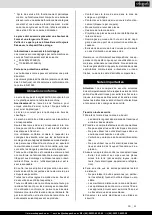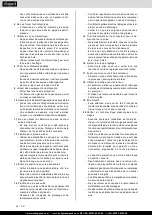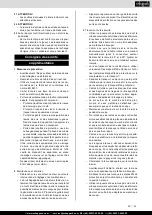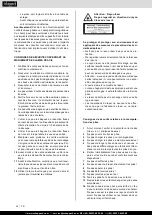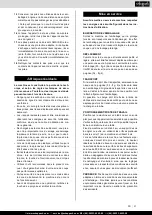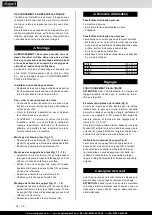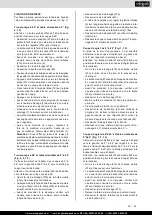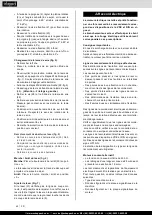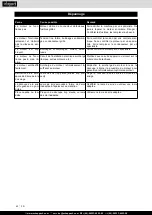
www.scheppach.com
+(49)-08223-4002-99
+(49)-08223-4002-58
27
GB
• Place a new saw blade on the inner saw blade
flange. In the process, observe the rotational di-
rection of the saw blade.
•
Fit the outer saw blade flange and firmly tighten
the screw.
• Move the saw blade guard back to the correct po
-
sition.
Replacing laser batteries (Fig. 6)
• Remove the laser battery cover (30). Remove the
2 batteries.
• Replace both batteries with the same or an equiva
-
lent type. Make sure that they are inserted with the
same polarity as the used batteries.
• Close the battery cover.
Switch ON / switch OFF the laser
(Fig. 6)
To switch on:
Move the ON/OFF (33) switch of the
laser (34) to the “1” position. A laser line is projected
onto the material you wish to process, providing an
exact guide for the cut.
To switch off:
Move the ON/OFF switch of the laser
to the “0” position.
Adjusting the laser (Fig. 7)
If the laser (31) ceases to indicate the correct cutting
line, you can readjust the laser. To do so, open the
screws (32) and set the laser by moving sideways to that
the laser beam strikes the teeth of the saw blade (5).
m
Electrical connection
The electrical motor installed is connected and
ready for operation. The connection complies
with the applicable VDE and DIN provisions.
The customer‘s mains connection as well as
the extension cable used must also comply with
these regulations.
Important information
In the event of an overloading the motor will switch
itself off. After a cool-down period (time varies) the
motor can be switched back on again.
Damaged electrical connection cable
The insulation on electrical connection cables is of
-
ten damaged.
This may have the following causes:
• Passage points, where connection cables are
passed through windows or doors.
• Kinks where the connection cable has been im
-
properly fastened or routed.
• Places where the connection cables have been cut
due to being driven over.
• Insulation damage due to being ripped out of the
wall outlet.
• Cracks due to the insulation ageing.
Such damaged electrical connection cables must not
be used and are life-threatening due to the insula-
tion damage.
• Before making a cut, check that the stop rail (27a)
and the saw blade (5) cannot collide.
• Secure the locking lever (27b) again.
• Move the machine head to the top position.
• Fix the rotary table (9) in the 0° position.
•
Loosen the set screw (23) and use the handle (2) to
angle the machine head to the left, until the pointer
(25) indicates the desired angle measurement on
the scale (24).
•
Re-tighten the fixing screw (23).
• Cut as described under section „Cross cut 90° and
turntable 0°“.
Mitre cut 0°- 45° and turntable 0°- 45° (Fig. 1, 2,
1.3)
The crosscut saw can be used to make mitre cuts to
the left of 0°- 45° in relation to the work face and, at
the same time, 0° - 45° to the left or 0° - 45° to the
right in relation to the stop rail (double mitre cut).
Important. To make miter cuts (inclined saw head),
the adjustable stop rail (27a) must be fixed at the
outer position.
•
Open the locking lever (27b) for the adjustable stop
rail (27a) and push the adjustable stop (27a) rail
outwards.
•
The adjustable stop rail (27a) must be fixed far
enough in front of the innermost position that the
distance between the stop rail (27a) and the saw
blade (5) amounts to a maximum of 8 mm.
•
Before making a cut, check that the stop rail (27a)
and the saw blade (5) cannot collide.
•
Secure the locking lever (27b) again.
•
Move the machine head to its upper position.
•
Release the rotary table (9) by loosening the set
screw (21).
•
Using the handle (2), set the rotary table (9) to the
desired angle (refer also to point “Cross cut 90°
and turntable 0° - 45°” in this regard).
•
Re-tighten the set screw (21) in order to secure
the rotary table.
•
Undo the locking screw (23)
•
Use the handle (2) to tilt the machine head to the
left until it coincides with the required angle value
(in this connection see also section “Mitre cut 0°-
45°”).
•
Re-tighten the fixing screw (23).
•
Cut as described under section “Cross cut 90° and
turntable 0°”.
Saw blade replacement (Fig. 5)
• Pull out the mains plug.
•
Place the saw unit in „cross-cutting“ position
• Unlock the moving saw blade guard (6) by pressing
the lock (3 - Fig. 1); in the process, raise the saw
blade guard so that the saw blade is free.
•
Actuate the spindle lock (22 - Fig. 3).
•
Loosen the saw blade fastening screw (28) - (
At-
tention: left-handed thread
).
•
Remove the screw (28) and saw blade flange (29).
• Carefully remove the saw blade (risk of injury from
the saw blade teeth).
Summary of Contents for HM80L
Page 185: ...185 ...





















